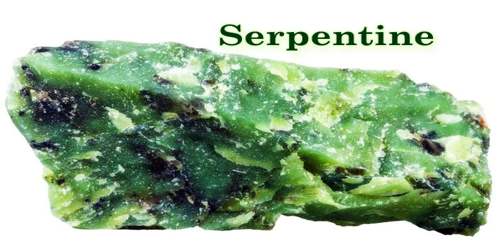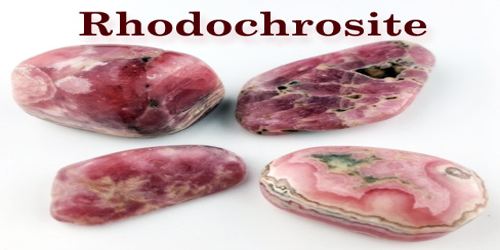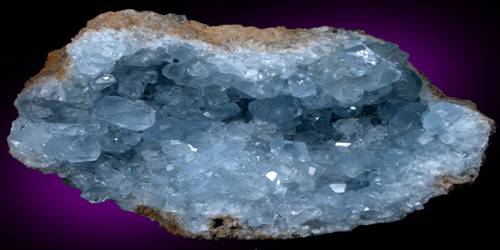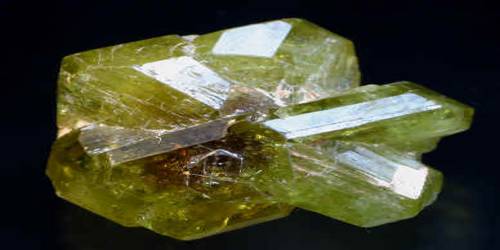Definition –
“Serpentinite” is a rock composed of one or more serpentine group minerals, the name originating from the similarity of the texture of the rock to that of the skin of a snake. It is any of a group of hydrous magnesium-rich silicate minerals. The composition of these common rock-forming minerals approximates Mg3Si2O5(OH)4. Minerals in this group, which are rich in magnesium and water, light to dark green, greasy-looking and slippery feeling, are formed by serpentinization, a hydration and metamorphic transformation of ultramafic rock from the Earth’s mantle. The mineral alteration is particularly important at the seafloor at tectonic plate boundaries.
Serpentine is not the name of a single mineral. Instead, it is a name used for a large group of minerals that fit this generalized formula: (X)2-3(Y)2O5(OH)4; In this formula, X will be one of the following metals: magnesium, iron, nickel, aluminum, zinc, or manganese; and, Y will be silicon, aluminum, or iron. The appropriate generalized formula is thus (Mg,Fe,Ni, Mn,Zn)2-3(Si,Al,Fe)2O5(OH)4.
Serpentine generally occurs in three polymorphs: chrysotile, a fibrous variety used as asbestos; antigorite, a variety occurring in either corrugated plates or fibres; and lizardite, a very fine-grained, platy variety. Named in allusion to its resemblance to a snake’s skin, serpentine is usually grayish, white, or green but maybe yellow (chrysotile) or green-blue (antigorite); the green color is due to iron replacing magnesium.
Serpentine group minerals have similar physical properties and form by similar processes. They often occur as fine-grained admixtures and can be difficult to distinguish within a rock. Geologists usually call these materials “serpentine” rather than more specific names to simplify communication.
It is the state rock of California, USA and the California Legislature specified that serpentine was “the official State Rock and lithologic emblem.” In 2010, a bill was introduced which would have removed serpentine’s special status as state rock due to it potentially containing chrysotile asbestos. The bill met with resistance from some California geologists, who noted that the chrysotile present is not hazardous unless it is mobilized in the air as dust.

Formation and Properties of Serpentinite –
Serpentinization is a geological low-temperature metamorphic process involving heat and water in which low-silica mafic and ultramafic rocks are oxidized (anaerobic oxidation of Fe2+ by the protons of water leading to the formation of H2) and hydrolyzed with water into serpentinite. Peridotite, including dunite, at and near the seafloor and in mountain belts is converted to serpentine, brucite, magnetite, and other minerals some rare, such as awaruite (Ni3Fe), and even native iron. In the process large amounts of water are absorbed into the rock increasing the volume, reducing the density and destroying the structure.
Serpentine minerals form where peridotite, dunite, and other ultramafic rocks undergo hydrothermal metamorphism. Ultramafic rocks are rare at Earth’s surface but are abundant at the oceanic moho, the boundary between the base of the oceanic crust and the upper mantle. During hydrothermal metamorphism, olivine and pyroxene minerals are transformed into or are replaced by serpentine minerals. Some of the metamorphic rocks produced here are composed almost entirely of serpentine minerals. These serpentine-rich rocks are known as “serpentinites.”
Serpentine is formed below 500 °C (930 °F) by the addition of water and sometimes silica to various magnesium silicates e.g., forsterite or enstatite. It characteristically occurs along the crests and axes of great folds, such as island arcs or Alpine mountain chains. Typical occurrences are in altered peridotites, dunites, or pyroxenites; serpentinite is a rock consisting largely of serpentine. Serpentine takes a high polish and is sometimes used as an ornamental stone.
Extensive areas of Earth’s surface are underlain by serpentinites. These areas occur near present or ancient convergent plate boundaries. They are locations where remnants of an oceanic plate is exposed at the surface. The remnant portion of the plate was either thrusted up onto land, accreted onto the edge of a land mass, or exposed by uplift and deep weathering. These areas of exposed oceanic plate are known as ophiolites. They are often the source of valuable minerals that might include magnetite, chromite, chrysoprase, jade, and serpentine.
The most obvious physical properties of serpentine are its green color, patterned appearance, and slippery feel. These remind the observer of a snake and that is where the name “serpentine” was derived.
Serpentine is also known for its translucent diaphaneity, waxy luster, ease of being cut into shapes, and its ability to accept a polish. These properties make it a popular gemstone, architectural material, and ornamental stone.
Soil cover over serpentinite bedrock tends to be thin or absent. Soil with serpentine is poor in calcium and other major plant nutrients, but rich in elements toxic to plants such as chromium and nickel.
Just like the symbol of the snake, the Serpentine crystal serves as a protective talisman that keeps you safe from psychic attacks. Whether people were returning to the great indoors for peaceful contemplation or forest bathing in the wilderness, wear Serpentine crystal jewelry and make any outfit pop with its waxy luster of bright green. Even better, when it’s combined with other complementary healing crystals, it creates a synergistic effect that infuses their spirit with a whimsical resilience. Elevate their soul and their everyday wardrobe with a two-in-one fashion statement that harnesses the infinite wisdom of Serpentine, the snake stone.
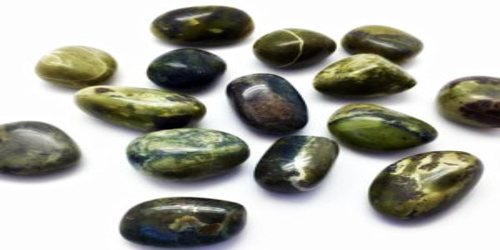
Uses and Benefits of Serpentinite –
Grades of serpentinite higher in calcite, along with the verd antique (breccia form of serpentinite), have historically been used as decorative stones for their marble-like qualities. College Hall at the University of Pennsylvania, for example, is constructed out of serpentine. Popular sources in Europe before contact with the Americas were the mountainous Piedmont region of Italy and Larissa, Greece.
Serpentine has been used as architectural stone for thousands of years. It is available in a wide variety of green and greenish colors, often has an attractive pattern, works easily, and polishes to a nice luster. It has a Mohs hardness of 3 to 6 which is softer than granite, and usually harder than most marble. This low hardness limits its appropriate use to surfaces that will not receive abrasion or wear, such as facing stone, wall tiles, mantles, and window sills.
The Serpentine crystal stone protects the heart with its powerful snake medicine, a strong force that helps give people an overall energy detox. Like a refreshing and nutritious green drink for the soul, the Serpentine crystal is like spring-cleaning for the soul. Just like its yellowish-green color that reflects the new growth of a forest, the Serpentine inspires you to start fresh, helping to clear away any psychic debris leftover from the past.
The Serpentine crystal reminds us that life is a series of choices, so choose wisely and always follow our bliss.
Serpentinite has a significant amount of bound water; hence it contains abundant hydrogen atoms able to slow down neutrons by elastic collision (neutron thermalization process). Because of this serpentinite can be used as dry filler inside steel jackets in some designs of nuclear reactors. For example, in RBMK series it was used for top radiation shielding to protect operators from escaping neutrons. Serpentine can also be added as aggregate to special concrete used in nuclear reactor shielding to increase the concrete density (2.6 g/cm3) and its neutron capture cross-section.
Some specimens of serpentine have a wonderful green color, clarity, and translucence. They are easily mistaken for fine jade by inexperienced buyers. The experienced buyer knows that serpentine polishes to a soft waxy luster rather than a bright glassy luster. Cabochons or beads with a waxy luster are not jade or they are jade with a poor polishing job.
Information Source:
